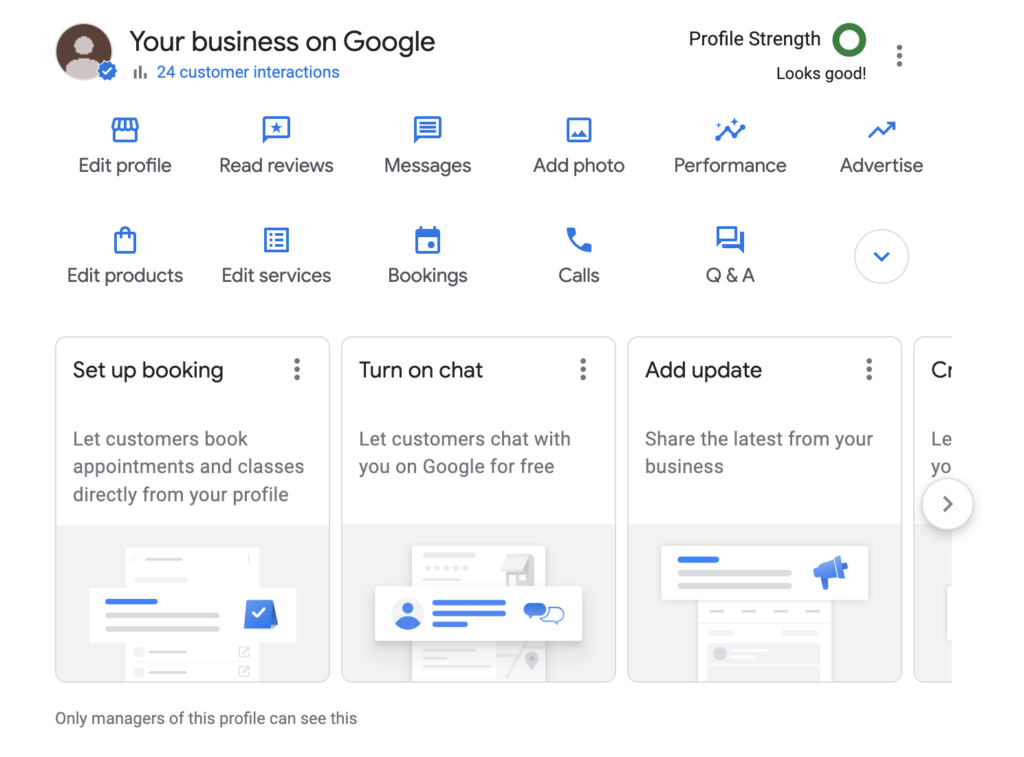Why Is Your Business Not Showing Up On Google?
An average person makes 3 to 4 Google searches each day. With more than 3.5 billion searches being received by Google every day, that’s a whopping 1.6 billion of them that include local intent. This means that your business misses so many customers when it is off Google.
Be On Top of Searches and Attract More
Customers
1. You have not claimed Google My Business account or it was not verified
Unsure about your verification status? A quick Google search can provide clarity. If you spot the prompt “Own this business?” beneath your listing, it means you’re yet to be verified. Verification options typically include postcard, phone, or Google video verification.
Upon successful verification, your business will appear on Google Maps during relevant searches. Elevate your visibility by ensuring accurate information and supplementing details. Enhance your business profile by incorporating images, videos, and a compelling description. Engage with reviews and address inquiries to further optimize your presence.
To check if your Google My Business is active:
go to Google Business Profile -> Manage Now
You have to see page like page below.

How To Fix It:
You can verify a GMB listing by mail, phone, or email. Some businesses are also eligible for instant or bulk verification.
Since most verifications are done through mail, here are the steps you should follow:
1. Sign into your GMB account.
2. Choose the listing you want to verify and click, “Verify now.”
3. Request your postcard; it may take up to 14 days to receive it in the mail.
4. After receiving your postcard, log back into your GMB account and click, “Enter verification code.”
5. Once prompted, enter the five-digit code on the postcard and click, “Verify.”
You may need to wait a few minutes for your verification to process. Avoid any delays with verification by not making any changes to your business address, name, category, or requesting another code. If you don’t receive a postcard after 14 days, contact support.google.com/business.
2.Your Business Information is Incorrect or Inconsistent Across the Citations
Google values consistency in your listings. When all your listings say the same thing, Google can confidently display your contact information to customers on applicable queries. When the search engine finds discrepancies in the listings, then it is not sure of the information. Since incorrect information can lead to a poor user experience, differences in NAP between your listings can cause lower rankings. To make sure that all NAP listings are correct:
Audit Your Current NAP Data: Conduct a thorough audit of your current NAP information on your website, social media profiles, online directories, and any other platforms where your business is listed.
Update Your Website: Verify that your business’s NAP details are prominently displayed on your website, preferably in the footer or contact page. Ensure that this information matches the details on your Google My Business (GMB) profile.
Claim and Optimize Google My Business (GMB): Claim your business on Google My Business and ensure that your NAP details are accurate. Optimize your GMB profile with relevant categories, business hours, and other pertinent information.
Update Social Media Profiles: Check and update your NAP details on all your social media profiles, ensuring consistency across platforms. This includes platforms like Facebook, Twitter, LinkedIn, and Instagram.
Check Online Directories: Identify relevant online directories and review platforms where your business is listed. Ensure that your NAP information is consistent across these platforms. Popular directories include Yelp, Yellow Pages, and industry-specific directories.
3. Your website is not optimized for SEO
4. Your Business is New and Has a Very Small Web Presence
How To Fix It:
Content Marketing: Create valuable and relevant content that addresses the needs and interests of your target audience. Regularly update your website with blog posts, articles, or other content that showcases your expertise.
Create a Professional Website: Develop a well-designed, user-friendly website that reflects your brand and provides relevant information about your products or services.
Optimize for Search Engines (SEO): Conduct keyword research and optimize your website content for search engines. This will improve your chances of appearing in relevant search results.
Mobile Optimization: Ensure that your website is mobile-friendly. Many users access the internet via mobile devices, and a mobile-optimized site improves user experience and search rankings.
Networking and Partnerships: Collaborate with other businesses, influencers, or organizations in your industry. Partnerships can help you tap into new audiences and strengthen your online presence.